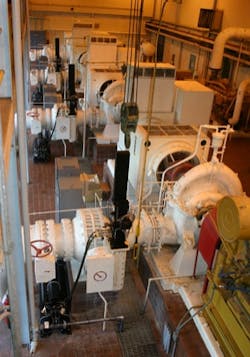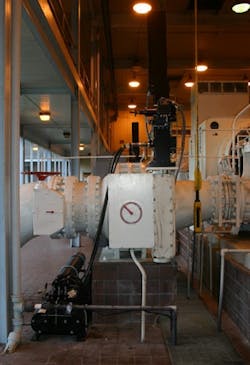Oil and water don't mix. Neither do oil leaks and EPA regulations. At Florida's City of Cocoa Claude H. Dyal Water Treatment Facility, this posed a problem. The accumulator system used for the hydraulic actuators contained more than 100 gallons of hydraulic fluid which frequently leaked.
"We had a common hydraulic tank that we utilized to actuate those four ball valves on our high service pumps," said Jeff Childers, the Dyal plant's Assistant Superintendent. "Not only was it a single point of failure for all four of those pumps, but it was a potential environmental hazard as a result of oil leaking on several occasions."
The plant had been in the process of replacing the electric actuators on its butterfly valves with Rexa electrohydraulic (Electraulic) actuators from Koso America. Carrying out a similar replacement on the ball valves resolved the leakage issues as well as improved reliability.
The city of Cocoa on Florida's Atlantic coast provides potable water to all of central Brevard County, including its own 16,000 residents as well as those in nine other cities, the Kennedy Space Center and all the cruise ships sailing out of Port Canaveral. The water comes from a mix of surface and ground sources.
The butterfly valves at the Dyal plant had been designed to use electromechanical actuators, but over time these had turned into a maintenance nightmare.
"We were having failures due to age and bad technology," said Childers. "This created a lot of downtime where I either had to send components back to the factory for major repairs or we had to repair equipment on site because of damaged actuators."
Looking for a long-term solution to these maintenance issues, the plant installed a Rexa Electraulic actuator on one valve as a trial in 2005. These self-contained actuators incorporate hydraulic, electronic and mechanical technologies. There are two main components – the Electraulic power module and a control enclosure. They do not require an external hydraulic pump or tubing, but operate by moving hydraulic fluid from one side of a double-acting cylinder to another.
The self-contained actuators incorporate hydraulic, electronic and mechanical technologies. There are two main components – the Electraulic power module and a control enclosure.
The power module contains a brushless DC motor, gear pump, flow match valve, and thermal expansion reservoir. Upon receipt of a control signal, the pump delivers oil at a nominal 2000 psi to one side or the other of a hydraulic cylinder, causing motion in the desired direction. Buyers can pick from four different sizes of motors depending on the pumping volume and maximum stroking speed desired. The two smaller units come with stepper motors, while the larger units use servo motors with faster frequency response. The hydraulic cylinders come in either linear or a rack and pinion rotary design. A position sensor is mounted within or adjacent to the cylinders and provides position feedback to the control electronics.
Within the control sub-assembly enclosure are the Central Processing Unit (CPU), power supply, and motor drivers. On the outside of the box (or inside it when conditions require) is a two-line display giving actuator status and a five button keypad used for set up and calibration of the actuator. The motor driver receives commands from the CPU and sends control signals to the motor - DC step pulses for a stepper motor or Pulse Width Modulated (PWM) DC voltage for a servo motor.
In operation, the CPU converts an incoming control signal to a target position and compares this with the current position as reported by the feedback assembly on the actuator. If the difference is outside the range preprogrammed by the user, the CPU will send a signal to start the motor. The motor then drives the reversible hydraulic pump to pressurize one side of the cylinder or the other, moving the piston in the desired direction. Once the desired position is reached, the pump shuts down and check valves close, locking the hydraulic fluid in the cylinder and maintaining the actuator position without having to keep the motor running.
Koso America makes a wide range of Electraulic actuators. The linear actuators come in sizes from 2000 lb thrust (8,896 N) to 600,000 lbs (2,668,933 N) with stroke lengths of .75" to 120" (2 to 305 cm). Rotary and drive actuators range from 600 lb/in torque (68 Nm) up to 800,000 lb/in (90,387 Nm).
Moving to a Standard Design
The City of Cocoa's maintenance team installed the actuator, provided power and hooked it into the plant's Intellution iFIX SCADA system. Bill Grabe, a sales engineer for Pro-Co, Inc. of Winter Springs, Florida, then came out to do the startup and calibration.
"Their instrument shop is very competent, which makes my job easy," said Grabe. "They had already installed the actuator onto the existing valves, mounted the electronics and terminated everything, so it only takes me a few minutes to do the start up."
The Electraulic actuator passed its initial tests for performance and reliability, so the city decided to standardize on this design, installing new actuators on the rest of its butterfly valves, about 40 total, ranging in size from 16 inches to 36 inches.
"Reliability and maintenance were the biggest issues, and the electrohydraulic actuators hardly require any maintenance," said Childers. "They also require less energy, have fewer electrical controls and operate at lower voltages."
Staff started replacing the actuators in 2008 and are now down to the last few small units. Some are two-position actuators while others are modulating. In most cases they were just installed on the existing valves. But, as can be expected at a 30-year-old plant, some valves needed replacement.
"We had one occasion recently with their filter drain valve, where the disk in the valve fell out," said Grabe, "so they had to buy a new valve before we could install the Rexa."
Rexa electrohydraulic (Electraulic) actuators from Koso America were installed at the City of Cocoa starting with a trial installation in 2005.
Eliminating Oil Leaks
With the butterfly valves under control, Childers next started looking at the ball valves on the high-service pumps. The city has four of the master pumps and normally only one operates at a time. The four pumps, however, shared a single hydraulic pump and accumulator system (HPU) operating four shut-off ball valves (one for at the outlet of each pump), so a failure would shut them all down. In addition, it would create a reportable environmental incident, such as in early 2009 when gallons of hydraulic fluid leaked into the room and into the plant's drain system.
The existing 24" Pratt ball valves had been in service for the last 25 years and the controls associated with the master pumps were fairly elaborate and outdated. It was crucial, therefore, to replace these actuators without affecting the existing controls. It was decided that, rather than replace the scotch yoke actuators with rotary actuators, a linear unit would be sized to replace the existing linear hydraulic cylinder. This allowed the plant to leave untouched all the existing switches and controls.
An accumulator system with food grade oil (Envirologic 3100) was provided for each Rexa linear unit (Model X2L20000-22-C-A) so that even if there is a leak it does not pose an environmental problem. Each unit only requires 1.5 gallons of oil or a total of 6 gallons for all 4 units, a significant reduction over the older 100 gallon system. Additionally, since the actuators use a sealed closed loop system, the oil does not degrade like it does in conventional systems. This eliminates the need for filters and oil changes, resulting in considerable savings in maintenance expense and oil disposal fees.
In August, the first of the four actuators was installed with the rest completed over the next few months. Like the actuators on the butterfly valves, these are performing as expected, Childers said. WW
More WaterWorld Current Issue Articles
More WaterWorld Archives Issue Articles





